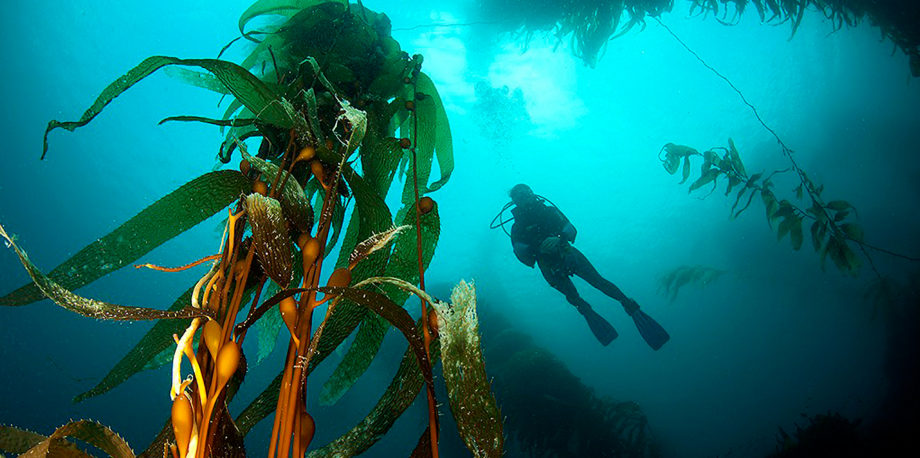导语
关键点:
本期的学术板块将目光投向珊瑚礁。现在全世界珊瑚礁科学家普遍同意,海洋环境而特别是珊瑚礁正在受到气候变化的不利影响。大多数科学家认为,气候条件的变化速度可能超出珊瑚礁的适应和复原能力。现在迫切需要科学家采取积极行动,推动政府和社区共同来应对这种风险。本期收录了从生产力、生物多样性、渔业等角度探讨气候变化对珊瑚礁影响的最新论文。
Highlight :
The academic section of this issue is looking at the coral reefs. Most of the coral reef scienctists agree that ocean environment and coral reefs are impacted negatively by climate change. Most of them think the rate of climate change is beyond the resilience and adaptation capacity of coral reefs. It is urgent for scientists to take active actions to encourage government and communities to jointly respond to this risk. This issue has collected recent papers discussing the impact of climate change on coral reefs from the perspectives of productivity, biodiversity and fishery.
时讯

(1)海带可以被埋入深海以固碳,或被收获以生产低排放的生物燃料和肥料。”海洋养生”是一种开放性海洋海藻养殖,它模仿野生海带林,以再生海洋生态系统,促进粮食安全和固碳。显著扩大海带阵列的规模最终覆盖大片深海,它们可以共同吸收数十亿吨的二氧化碳,同时以贝类养殖和鱼类栖息地的形式保障粮食安全。全球海洋恢复联盟 “海洋2050 “目前正在帮助制定一项碳信用计划,该计划可用于海藻养殖。这可能意味着未来可能会将碳信用额度投资于海带养殖场,或者将野生森林恢复算作减缓气候变化举措。
Kelp can be buried in the deep ocean to sequester carbon or harvested to produce low-emission biofuels and fertilizers. “Ocean Nourishment” is an open ocean kelp culture that mimics wild kelp forests to regenerate marine ecosystems for food security and carbon sequestration. Significantly scaling up kelp arrays to eventually cover large swaths of the deep ocean, they can collectively absorb billions of tons of carbon dioxide while safeguarding food security in the form of shellfish farming and fish habitat. The Global Ocean Restoration Alliance, Oceans 2050, is currently helping to develop a carbon credit scheme that could be used for kelp farming. This could mean that carbon credits could be invested in kelp farms in the future, or that wild forest restoration could be counted as a climate change mitigation initiative.
(2)持续近20年的WTO渔业补贴谈判仍有可能在今年收官,中国的态度对协议达成至关重要。今年6月25日,WTO规则谈判小组主席、哥伦比亚大使圣地亚哥·威尔斯(Santiago Wills)向各成员国代表分发了新一版协议草案。7月21日,各国代表在一次闭门磋商后决定将于9月开始对草案进行“不间断磋商”,并争取在年底前达成有关削减渔业补贴的协议。中国驻WTO代表张向晨表示支持达成协议的时间表,并准备“充分参与”密集的谈判。
The WTO negotiations on fisheries subsidies, which have lasted for nearly 20 years, are still likely to be concluded this year, and China’s attitude is crucial to reaching an agreement. On June 25 this year, Colombia’s ambassador Santiago Wills, chairman of the WTO Negotiating Group on Rules, circulated a new version of the draft agreement to the representatives of member countries, and on July 21, after a closed-door consultation, the representatives decided to start “continuous consultation” on the draft in September. The Chinese government is also trying to reach an agreement on cutting fisheries subsidies by the end of the year. China’s representative to the WTO, Zhang Xiangchen, expressed support for the timetable for reaching an agreement and readiness to “fully participate” in the intensive negotiations.
(3)根据太平洋群岛渔业科学中心的研究人员的一项新研究,测量夏威夷周围微观海洋植物的分布范围可以可靠地预测夏威夷深海延绳钓船队四年后的大眼金枪鱼捕获率。目标物种渔获率的可靠预测可帮助渔业确定捕捞活动的时间和规划资本改进。它还可能为适应性管理提供信息,并促进基于生态系统的渔业管理。
Measuring the extent of microscopic ocean plant life around Hawaii could reliably predict bigeye tuna catch rates four years out for Hawaii’s deep-set longline fleet, according to a new study by researchers at the Pacific Islands Fisheries Science Center. A reliable predictor of targeted species catch rates could help the fishery time fishing activity and plan capital improvements. It could also potentially inform adaptive management and facilitate ecosystem‐based fisheries management.
(4)NOAA渔业局宣布,南加州沿海和墨西哥湾的联邦水域将成为美国未来水产养殖机会区的前两个调查区域。这些地区是根据美国总统特朗普发布的一项行政命令选择的,该命令的目标是增加美国国内的水产养殖产量,该命令的一部分规定在联邦水域内确定 “至少两个 “适合商业水产养殖的地理区域。
NOAA Fisheries has announced that federal waters off the coast of Southern California and in the Gulf of Mexico will be the first two regions investigated for future Aquaculture Opportunity Areas in the U.S. The areas were chosen for initial assement following on an executive order by U.S. President Donald Trump issued with the goal of increasing domestic aquaculture production in the U.S. One part of the order stipulated the identification of “at least two” geographic areas within federal waters that would be suitable for commercial aquaculture within a year of the order.
(5)根据福建省海洋与渔业局的数据,2020年上半年该省海产品总产量为410万吨–从数量上看增长4.1%,从价值上看增长3.7%,达到604亿元人民币(84.5亿美元,72亿欧元)。福建的数据显示远洋渔获量激增,与中国远洋船队的另一个中心浙江省的类似数据相吻合。浙江省农业局上周公布的一份文件显示,今年上半年,来自舟山主要渔港的220艘远洋船上岸渔获7.49万吨,比去年同期增长15.7%。据省农业部统计,2020年上半年浙江全省渔业产量同比增长17.1%。这两个地区的数据似乎表明,中国远洋渔获量持续增加,很大程度上得益于政府支持。
The province’s total seafood output in the first half of 2020 totaled 4.1 million tons, according to the Fujian Ocean and Fisheries Bureau – up 4.1 percent in volume terms and up 3.7 percent in value terms to CNY 60.4 billion (USD 8.45 billion, EUR 7.2 billion). Fujian’s data showing an upsurge in distant-water catches matches similar data from Zhejiang, another hub of the Chinese distant-water fleet. A document from the Zhejiang agriculture bureau published last week suggests that 220 distant-water vessels from the leading fishing port of Zhoushan landed 74,900 tons in the first half of the year, up 15.7 percent on the same period last year. Fishery output for the province of Zhejiang rose by 17.1 percent year-on-year in the first half of 2020, according to the provincial Agriculture Ministry. The data from both regions seems to suggest a sustained increase in China’s distant-water catch, in large part thanks to government support.
观点

(1)IISD | SDG Knowledge Hub:“《生物多样性公约》第十五届缔约方会议已改期至2021年中举行,将通过2020年后的《全球生物多样性框架》。与此同时,线上讨论、磋商以及某种程度上的谈判正在进行。本文强调了《生物多样性公约》进程中程序性和实质性发展方面的三个关切:(a)全球生物多样性框架不限成员工作组没有对在新冠疫情期间出现的治理问题作出适当反应;(b) 线上谈判进程的透明度和公平性;(c)目前在附属科学技术咨询机构第24次会议之前有待审查的内容。”
IISD | SDG Knowledge Hub:” CBD COP 15, set to adopt the post-2020 Global Biodiversity Framework, has been rescheduled for early 2021. In the meantime, virtual discussions, consultations and to some extent negotiations are ongoing. This article highlights three concerns regarding procedural and substantive developments within the CBD process. (a) the Open-Ended Working Group for the Global Biodiversity Framework has not responded appropriately to governance concerns that have arisen during the COVID-19 pandemic; (b) transparency and equity in virtual processes for negotiation; (c) the content currently up for review ahead of the 24th meeting of the Subsidiary Body on Scientific and Technological Advice.”
(2)Christopher Costello等:“我们研究了海洋中主要的食物生产部门–野生渔业、鱼类养殖和双壳类养殖–来估算’可持续供应曲线’,并考虑到生态、经济、监管和技术限制。我们将这些供应曲线与需求情景叠加在一起,以估计未来海产品产量。我们发现,根据我们估计的需求变化和供应情景(考虑到政策改革和技术改进),到2050年,来自海洋的食品可能增加2100万-4400万吨,比目前的产量增加36-74%。这相当于到2050年养活98亿人所需增加的全部肉类的12-25%。所有三个领域都有可能增加,但海产养殖业的增长最为明显。这些生产潜力能否可持续地实现,将取决于政策改革、技术创新和未来需求变化的程度等因素。”
Christopher Costello et al.:” Here we examine the main food-producing sectors in the ocean—wild fisheries, finfish mariculture and bivalve mariculture—to estimate ‘sustainable supply curves’ that account for ecological, economic, regulatory and technological constraints. We overlay these supply curves with demand scenarios to estimate future seafood production. We find that under our estimated demand shifts and supply scenarios (which account for policy reform and technology improvements), edible food from the sea could increase by 21–44 million tonnes by 2050, a 36–74% increase compared to current yields. This represents 12–25% of the estimated increase in all meat needed to feed 9.8 billion people by 2050. Increases in all three sectors are likely, but are most pronounced for mariculture. Whether these production potentials are realized sustainably will depend on factors such as policy reforms, technological innovation and the extent of future shifts in demand.”
(3)Mukhisa Kituyi和Dona Bertarelli:“可持续的蓝色经济复苏对于发展中国家和小岛屿发展中国家的人民来说尤其重要。我们必须确保公平、再生和可持续的蓝色经济复苏,通过增强生态系统的复原力,从而提高生计,来抵御未来的全球危机。蓝色复苏议程应包括对粮食安全的监管、结束有害的渔业补贴、部署蓝色金融和基于海洋的研究等。”
Mukhisa Kituyi and Dona Bertarelli:” A sustainable blue economic recovery is critical especially for people in developing countries and the Small Island Developing Statesthat. We must ensure an equitable, regenerative and sustainable blue economic recovery to cushion us against future global crises by enhancing the resilience of ecosystems and thus livelihoods. The blue recovery agenda should include regulation for food security, ending harmful fisheries subsidies, deploying blue finance and marine-based research etc. “
(4)Shawna A. Foo等:“禁止刺网、水族馆收集和鱼叉捕鱼相结合的海洋保护区在维持和/或增加所有功能组的鱼类生物量方面最为有效。我们发现,污染、捕鱼和栖息地驱动因素都影响鱼类生物量的变化,其中最不利的影响是来自陆地污水处理的氮输入。鱼类生物量与我们研究的驱动因素的关系取决于鱼类的功能分组。对于刺尾鱼而言,生物量的变化与礁石皱度的变化关系最为密切。对于鹦鹉鱼而言,生物量由商业捕捞量的变化来解释更好,目前的商业捕捞水平对刮鳞鱼种群有负面影响。观察结果表明,对包括生境、污染和渔业在内的多种因素进行区域管理,将有利于夏威夷岛附近资源鱼类的生物量。”
Shawna A. Foo et al.:” Marine Protected Areas that prohibited a combination of lay nets, aquarium collection, and spear fishing were most effective in maintaining and/or increasing fish biomass across all functional groups. We found that pollution, fishing and habitat drivers all contributed to changes in total fish biomass, where the most negative impact was nitrogen input from land‐based sewage disposal. Fish biomass relationships with our study drivers depended on fish functional grouping. For surgeonfish (grazers), changes in biomass linked most strongly to changes in reef rugosity. For parrotfish (scrapers), biomass was better explained by changes in commercial catch where current commercial fishing levels are negatively affecting scraper populations. Our observations suggest that regional management of multiple factors, including habitat, pollution and fisheries, will benefit resource fish biomass off Hawai‘i Island.”
(5)The High-Level Panel for a Sustainable Ocean Economy:“渔业相关的有组织犯罪剥夺了国家的收入,并威胁到合法的渔业和依赖渔业的人的生计。有组织犯罪的持续存在破坏了全球对可持续发展和实现可持续海洋经济的承诺。然而,尽管有大量证据表明,有组织犯罪在渔业产生了动态的破坏性影响,但仍然需要在国家和全球层面采取有效、协调的执法对策。为了全面解决渔业有组织犯罪问题,各国应首先在全球范围内建立对该问题的共同认识,其次,在有利的立法框架和提高透明度的推动下,在国内开展以情报为主导、以技能为基础的合作执法。”
The High-Level Panel for a Sustainable Ocean Economy:” Organised crime deprives states of national revenue and threatens the legitimate fishing industry and the livelihoods of those that rely on it.The continuation of organised crime in fisheries undermines the global commitment to sustainable development and the realisation of a sustainable ocean economy. Yet despite significant evidence of the dynamic and destructive impact of organised crime in the fisheries sector, the need remains for an effective, coordinated enforcement response at the national level and globally. To comprehensively address organised crime in fisheries, states should, first, build a shared understanding of the problem globally and, second, undertake intelligence-led, skills-based cooperative law enforcement at the domestic level facilitated by enabling legislative frameworks and increased transparency.”
学术
(1)【气候·生态】从厄尔尼诺和太平洋年代际涛动事件预测珊瑚礁未来
[Climate change·Ecosystem] Predicting coral-reef futures from El Niño and Pacific Decadal Oscillation events
研究表明,自1980年以来,厄尔尼诺-南方涛动(ENSO)和太平洋年代际涛动(PDO)共同预测了(i)与珊瑚漂白和珊瑚覆盖率下降有关的最高海面温度(SST);(ii)与珊瑚捕食性海星的高密度有关的最高叶绿素a浓度。正的PDO和负的ENSO(即拉尼娜现象)之间的不同步与年海温的峰值有关。相反,正的PDO和正的ENSO(即厄尔尼诺现象)之间的同步与叶绿素a的峰值有关。这两种情况都会导致生态扰动和珊瑚覆盖率的显著下降。 2015/17ENSO事件与正的PDO结合在一起,导致密克罗尼西亚东部的海温和虾夷鱼丰度较高,而密克罗尼西亚西部则出现了积极的珊瑚生长。
(2)【气候·生态】东热带太平洋地区珊瑚礁对热应力的复原力
[Climate change·Ecosystem] Coral reef resilience to thermal stress in the Eastern Tropical Pacific
源自东热带太平洋(ETP)的厄尔尼诺-南方涛动(ENSO)事件通常导致频繁的珊瑚礁损失。然而,经过反复的热应激干扰,如1997-1998年厄尔尼诺现象造成的干扰,ETP珊瑚礁表现出区域性的持久性和恢复力。研究发现,在1970-2014年期间,ETP珊瑚覆盖率在重大ENSO事件后表现出暂时的减少,但没有整体下降。此外,ETP珊瑚礁的恢复模式允许珊瑚在这些厄尔尼诺压力条件下持续存在,通常在10-15年内从这些事件中恢复。累积的热应激解释了ETP中活珊瑚覆盖率31%的整体年变化率。这表明迄今为止,ETP珊瑚礁已经适应了极端热环境,并且可能有能力适应近期的未来气候变化热异常。
(3)【气候·生态】海面温度对珊瑚礁修复结果的影响
[Climate change·Ecosystem] Sea surface temperature in coral reef restoration outcomes
珊瑚礁的成功恢复取决于外植物种的生存。研究表明,外植物种的存活率参差不齐,外植物种往往在各种压力下迅速死亡。研究发现,外植地经历的最高温度对决定外植体存活率非常重要,如果温度达到30.5℃,就会出现约50%的死亡。然而,有些珊瑚属比其他珊瑚属更能忍受高温:当种植地的温度变化较大且外植体暴露在比长期平均值更高和更低的温度下,外植体的存活率会增加。当考虑外植前一年的温度条件时,也发现了类似的结果。因此,海面温度数据可以作为评估修复地点是否合适的工具,地点选择可以提高外植体的存活率。
(4)【气候·生态】即使是生物多样性的珊瑚礁也仍然容易受到气候变化和入侵物种的影响
[Climate change·Ecosystem] Even biodiverse coral reefs still vulnerable to climate change and invasive species
生物多样性和生态系统功能(BEF)之间的积极关系强调了保护生物多样性以维持关键生态系统功能及相关服务的重要性。研究证明了生物多样性与两个生态系统功能(生物量和生产力)的强烈、非饱和关系。这些积极的关联在引发珊瑚漂白的极端热浪和扰乱本地海鸟营养补充的入侵鼠的案例中都是明确的。尽管对BEF关系的影响不大,但这两种压力因素仍然通过其他途径降低了生态系统的功能。极端热浪降低了生物多样性,由于BEF关系强烈,最终降低了两种生态系统功能。相反,跨系统养分补贴的丧失直接降低了生物量。这些结果表明,在自然的高多样性组合中,尽管有强大的BEF关系,但人类造成的压力因素依然可以通过多种途径降低生态系统功能。
(5)【海洋生态】极端环境条件降低了珊瑚礁鱼类的生物多样性和生产力
[Marine Ecosystem] Extreme environmental conditions reduce coral reef fish biodiversity and productivity
研究表明,尽管底栖生物组成和活珊瑚覆盖率相当,但阿拉伯湾的珊瑚礁组合多样性只有阿曼湾的一半,而丰富度却不到其25%。这种模式似乎是由对环境极端情况的反应和不同的猎物资源供应造成的能量不足所驱动,而不是绝对的热耐受性。因此,在地球上最热的阿拉伯湾珊瑚礁上,通过隐栖鱼类组合生产、转移和补充生物量的现象大大减少。预计21世纪末的极端环境条件而不是活珊瑚损失,会破坏一个关键功能群体的群落结构和生产力。
(6)【海洋生态】人工鱼礁增加生境受限河口的鱼类数量
[Marine Ecosystem] Artificial reefs increase fish abundance in habitat‐limited estuaries
研究表明在人工鱼礁上看到的鱼并不是从附近的岩礁上吸引来的,很可能是在这些河口增加人工鱼礁后 “生产 “出来的。人工鱼礁可以为这些河口提供原本无法利用的避难所,从而增加这些河口的承载力。拥有人工鱼礁和天然鱼礁的河口的鱼类丰度增加表明,专门建造的人工鱼礁可以与恢复/保护现有的自然生境一起使用,以增加河口的承载能力和鱼类丰度,增强渔业或恢复河口。
(7)【气候·渔业】气候变化、热带渔业和可持续发展的前景
[Climate change · Fisheries] Climate change, tropical fisheries and prospects for sustainable development
受海洋变暖、酸化、脱氧和海平面上升的影响,在温室气体持续高排放的情况下,到2050年代,一些热带专属经济区的热带鱼类种群的最大捕捞潜力预计将比2000年代下降40%。气候变化对热带渔业的影响(渔业生产减少和鱼类物种构成改变)将影响当地经济和社区的可持续发展,使适应能力有限的热带国家更加脆弱,并通过海产品贸易和远洋渔业等人与自然系统的 “远距离耦合 “影响热带以外地区。对热带发展中国家的主要影响将是降低其实现包括粮食安全(SDG2)、减贫(SDG1)和经济增长(SDG8)的联合国可持续发展目标的能力。需要在所有适当的利益相关者参与和支持政策的基础上,为小规模渔业和工业化渔业提供有效和实用的适应解决方案,以维持热带地区的渔业生产力。
其他资料
【海洋污染】石油泄漏对珊瑚礁影响的应对与规划思考
[Marine Pollution] Oil Spills in Coral Reefs: Planning & Response Considerations
【海洋宏观】海上安全与和平
[Ocean in General] Security and Peace on the Ocean
【蓝色经济】经济学人之世界海洋倡议 | 到2030年实现可持续海洋经济的机遇与挑战
[Blue Economy] A sustainable ocean economy in 2030: opportunities and challenges
【蓝色经济】可持续海洋经济高级别小组 | 到2050年实现可持续海洋经济的利益与成本
[Blue Economy] A sustainable ocean economy for 2050: approximating its benefits and costs
活动
>>预告
2020年9月9日 新冠疫情对沿海和海洋旅游业的影响
2020.09.09 The impacts of COVID-19 on coastal and marine tourism
详情/Detail
2020年9月23日 “循环资本”海洋基金:一个开创性防止海洋塑料的1亿美元投资基金
2020.09.23 Circulate Capital Ocean Fund: A pioneering, $100M investment fund to prevent ocean plastic
详情/Detail
2020年10月2日 气候变化对海洋空间规划的影响:途径和解决办法
2020.10.02 The effects of climate change in marine spatial planning: pathways and solutions
详情/Detail
2020年10月20日 “清洁洋流联盟”:全球合作解决复杂塑料问题的办法
2020.10.20 The Clean Currents Coalition: A global collaborative solution to the complex plastics problem
详情/Detail
>>回顾
2020年5月12日 “后新冠疫情”海洋经济:我们该何去何从?
2020.05.12 The post-coronavirus ocean economy: where do we go from here?
详情/Detail
2020年5月28日 海鲜的未来:我们如何养活世界?
2020.05.28 The future of seafood: how can we feed the world?
详情/Detail
2020年6月8日 世界海洋日:如果你能在一个海洋问题解决方案上投资10亿美元,那会是什么?为什么?
2020.06.08 World Oceans Day: if you could invest US$1bn in one ocean solution, what would it be and why?
详情/Detail
2020年6月10日 管理塑料垃圾,从源头到海洋的解决方案
2020.06.10 Solutions to manage plastic waste from source to sea
详情/Detail
2020年7月23日 “蓝色复苏”系列 | 确保亚洲及太平洋地区实现强劲的 “蓝色复苏”
2020.07.23 The Blue Recovery Series: ensuring a robust ‘blue’ recovery in Asia and the Pacific
详情/Detail
2020年8月13日 认识海洋变革者
2020.08.13 Meet the ocean changemakers
详情/Detail
2020年8月26日 科学、创新和“蓝色复苏”
2020.08.26 Science, innovation and the blue recovery
详情/Detail
2020年7月17日新冠疫情对渔业和水产养殖业的影响:效应、良好实践和建议
2020.07.17 Impacts of COVID-19 on fisheries and aquaculture: Effects, good practices and recommendations
详情/Detail
>>其他
本简报两周更新一期,往期内容可以查看这里。 如果您在简报内容或形式上有任何意见或建议,欢迎发邮件至ocean@ghub.org告诉我们,也欢迎您将《蓝色脉搏》推荐给同事和朋友。



